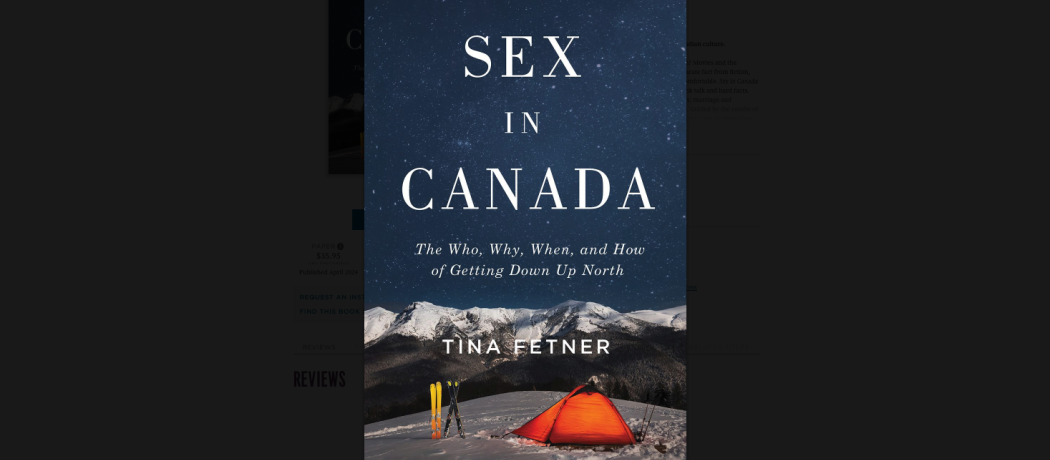By Dr Tina Fetner, Professor and Chair, Sociology Department, McMaster University.
UBC Press, 2024. ISBN: 9780774869515. Paperback, 204 pages.
I recently read this excellent book, Sex in Canada: The Who, Why, When and How of Getting Down Up North, which offers a picture of Canadians’ sex life before the recent pandemic and explains the who, why, when, and how we act. The book presents data on how things are, it offers no opinions on how sex in Canada should be.
The picure of sex in Canada is presented in the book in six main topics:
- Chapter one: The role of sexual identity in shaping the Canadian world, influencing our understanding of sexuality, while influencing family, community, and the social order.
- Chapter two: How much sex we’re having.
- Chapter three: The commitment between partners outside of a sexual relationship.
- Chapter four: Sexual behavior: What we’re doing, and how that may vary by gender, age, or sexual identity.
- Chapter five: What behaviors are pleasurable, what leads to orgasm, why men climax more often than women. It also focuses on pain, the feeling of pressure, and the risk of poor sexual health outcomes.
- Chapter six: The social organization of sexuality: How location, religion, education, anglophone or francophone background, or left or right political leaning influence sexual choices.
Each chapter is richly illustrated with simple statistical charts such as percentage distributions of the gender of sexual partners of men: straight, gay, bisexual; proportion of age groups who never masturbate; condom use relating to sexual identity; and how individuals met their partner. The charts show the distribution of respondents by gender, sexual identity, love between sexual partners, love and intimacy, and by relationship.
The survey behind the findings
A team of sociologist and political scientists used a quota-based sampling method to recruit a sample of study participants matching the proportions of Canadians in gender, age, region of residence, and visible minority status. Participants completed an online survey in 2018, without any personal contact with others. When asked about gender identity, the survey asked what the respondents’ gender identity was now, in contrast with what it was at birth. The survey attempted to learn about sexual identity, behavior, desire, pleasure, discomfort, pain, and intimacy with a partner.
The author and colleagues considered the reports clearly showing that there is a gender gap in orgasms in mixed-gender sex. Women reported achieving orgasm in around 60% of the occasions, whereas men reported over 80%. Follow-up interviews led to a simple finding: what goes on in bed usually concentrates on the penis rather than the clitoris. Add to that the myths that women’s bodies are inadequate, their private parts are unclean, and they are not keen on orgasms anyway. Women were most likely to climax when they or their partner stimulated their clitoris, often orally.
The survey indicated that Canadians’ sexuality and sexual behavior vary in a patterned way, along with other aspects of life. Age, education, religion, political inclinations, and sexual identities such as straight, gay, lesbian, and bisexual, influence but do not determine the gender of our partners. Our sexual identity also influences our sexual behaviors. For example, women use vibrators and other sex toys more often with women sexual partners than with men. Respondents also seem to share sexual behaviors with those of similar postsecondary education, language and culture, and religion. For example, data showed that masturbation was more frequent in Quebec than in other parts of the country. Religious affiliation has much to do with our sense of self and sexual morality. The survey showed that people with certain religious affiliations organized their sexual behavior differently from those who had none. Respondents who saw themselves as politically liberal engaged in a wider variety of partnered sexual behavior. Of significant interest is that the survey debunked beliefs that White Canadians have different sexual inclinations than members of racialized groups.
The flourishing of LGBTQIA2S+ communities has been essential to the creation of Canada’s multicultural sexual reality. What was once a community banding together for protection against the punitive and exclusionary heterosexual world is now a site of sexual multiculturalism. While heterosexuality prevails, the survey has shown that more and more people organize their lives in ways that feel true to them.
As a former clinician, teacher, and researcher in the fields of sexual medicine and sexual rehabilitation, I found Fetner’s thoughtful sociological exploration and presentation of Canadian’s intimate, private, personal yet also social sexuality an invaluable tool for practitioners in many health and social care fields. Her work also provides a baseline to which the landscape of sexual behaviors of future generations of Canadians may be compared.
—George Szasz, CM, MD
This post has not been peer reviewed by the BCMJ Editorial Board.
 |
| This work is licensed under a Creative Commons Attribution-NonCommercial-NoDerivatives 4.0 International License. |

